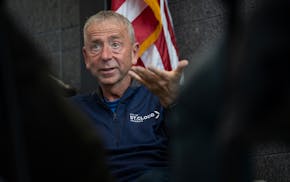Ron DeSantis and Mike DeWine were elected in 2018 to govern swing states. Both are Republicans and have last names starting with "De."
Their similarities end when it comes to how the governors of Florida and Ohio have managed the coronavirus in their states. Ohio's DeWine has been resolute, decisive and serious. DeSantis has been meek, unsure and flippant. DeWine has led from the front; DeSantis from behind.
Floridians have noticed, and they're not happy. While the post-pandemic popularity of many governors is soaring because of their responses — DeWine is up by 35 points — DeSantis is down by 7.
This isn't just about polls. It's also about public health outcomes. In one key category, Ohio has reported nearly 7,000 coronavirus cases, or 60 cases for every 100,000 people. Florida has reported more than 20,000 cases, a rate of about 100 cases for every 100,000 people.
A look back at the two governors' responses might explain why Ohio appears to be doing better in controlling the spread of infection than Florida, or at least taking it more seriously.
Both declared a state of emergency on March 9, but what likely made a difference is what followed those declarations:
• Stay-at-home orders. DeWine issued an executive order effective March 24 for people to stay at home except for essential trips. DeSantis dawdled until April 3, relying on an ineffective patchwork of local government orders. Even then, DeSantis' order has been confusing, not clarifying, with local officials in some cases unable to determine where and how it applies.
• School closings. DeWine ordered schools to shutter into April on March 12. DeSantis waited until March 17.
• Restaurants, bars and clubs. DeWine shut them all down on March 15, allowing restaurants to continue takeout and delivery. DeSantis wasn't far behind, closing bars and clubs on March 17 but, once again, opted for half measures by allowing restaurants to stay open if they reduced seating capacity by 50%. A few days later, March 20, he ordered them all closed except for takeout and delivery.
• Gyms, fitness centers, movie theaters, bowling alleys. Ohio closed them on March 16. Florida waited until March 20, then only closed gyms and fitness centers.
• Barbershops, hair and nail salons. Ohio closed them on March 18; Florida on April 3.
• Elective surgeries and procedures. Ohio stopped them on March 17; Florida on March 20.
Some of the gaps were short, but every day matters in this emergency, something DeWine recognizes better than DeSantis.
Nothing is easy about the challenges faced by American governors.
But what we're witnessing are governors like Mike DeWine who rise to the challenge, and governors like Ron DeSantis who, at least so far, seem ill-suited to leadership in a time of crisis. People look to their leaders during frightening times. Ohio's governor is inspiring confidence; Florida's is not.
FROM AN EDITORIAL IN THE ORLANDO SENTINEL

Kudos to St. Cloud's longtime mayor
Readers Write: Ethnic studies curriculum, public notice laws, student protests


